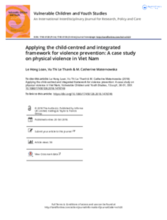ABSTRACT
In 1986, the Government of Viet Nam introduced a package of economic reforms known as Doi Moi (open door) policy that transformed the previously centrally planned, vertically oriented, largely agricultural economy into a market system in which trade opened up to the rest of the world. By 2013, Viet Nam became a lower middle-income country with a highly diversified economy. This rapid economic development and increasing global connectedness have brought many benefits for Vietnamese children, but also new risks. The Vietnamese Government has already done much to document and mitigate the effects of social and economic change through targeted poverty reduction programmes, expanding formal education and employment, implementing a family planning programme, promoting gender equality and early childhood care and education, introducing social assistance schemes and other support programmes for vulnerable people. Yet, high rates of violence affecting children persist and Viet Nam’s social welfare system struggles to keep pace with the rapid growth of related emerging needs. Applying the Integrated Framework for Violence prevention, a revised social ecology framework, provided scholars and practitioners in Viet Nam with a new way to both visualize and translate data into more meaningful plans for effective violence prevention.
This article presents the findings of a study that set out to understand what drives violence in Viet Nam as part of the Multi-Country Study on the Drivers of Violence Affecting Children.

